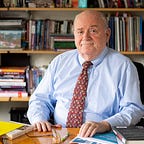What, Exactly, Is Infrastructure?
By Anthony P. Carnevale and Nicole Smith
Our recent report analyzes the economic impact of the Biden-Harris administration’s infrastructure plan. You may wonder why we focused on the traditional infrastructure spending in the American Jobs Plan, which will cost more than $2 trillion.
The question about what, exactly, constitutes infrastructure has dominated the discussion since President Joe Biden announced his infrastructure plan at the end of March. The plan, which includes childcare tax credits and funding for eldercare and education, takes a broad view of infrastructure. It incorporates the domestic needs of the potential infrastructure workforce with the goal of making the entire program more productive.
Sen. Bernie Sanders has promoted expanding the definition of infrastructure to “human infrastructure,” while Sen. Kirsten Gillibrand tweeted: “Paid leave is infrastructure. Child care is infrastructure. Caregiving is infrastructure.” On the other hand, Republicans have sought to narrow the focus to traditional infrastructure such as roads and bridges, while advocating for less spending.
The program would create jobs directly related to the 20,000 miles of highways, roads, and 10 economically significant bridges, as well as in downstream industries serving the needs of the infrastructure. Our research studied the economic impact of the American Jobs Plan — specifically, how many jobs would be created, where, and for whom — and estimated the training and education needed to ready workers for those jobs. With that in mind, we included the following provisions of the Biden-Harris proposal that have the potential to create or save jobs:
- $620 billion for transportation,
- $286 billion for buildings,
- $266 billion for utilities,
- $174 billion for electric vehicles, and
- $300 billion to revitalize manufacturing.
We found that, over eight to 10 years, these measures would create or save 15 million jobs. Seventy-five percent of the jobs would be for workers with no more than a high school diploma and some non-degreed short-term postsecondary training. As a result, the plan would temporarily revive the blue-collar economy as the share of infrastructure jobs increases from 11 percent to 14 percent of all jobs in the US economy.
Creating jobs would be only the first step, though, because workers would need training to do them. Of the jobs created through the infrastructure program, our research shows that 60 percent would require no more than six months of training, and 40 percent would require more than six months of training. The postsecondary education system, as well as apprenticeships, would play a major role in preparing workers to perform infrastructure jobs over the next decade.
An infrastructure program would be good medicine to nurse the economic wounds inflicted by the COVID-19 pandemic. However, the jobs it would create would not be spread evenly among workers. Men are likely to fill a majority of the jobs created by the infrastructure program because they currently hold 90 percent of infrastructure jobs. We hope that the plan will develop into a bill that incorporates provisions for improving equality of opportunity by gender.
A full economic recovery would enable women to return to the workforce, too. Women accounted for slightly more than half the workforce in January 2020, but they disproportionately left the workforce during the COVID-19 recession. In the early months of the pandemic, we found that women were four times as likely as men to report that they were not working so they could care for children who were not in school or daycare.
That’s where the remainder of the American Jobs Plan spending comes in. The plan contains funding for childcare tax credits, $400 billion for eldercare, and $137 billion for education. Whether or not these are infrastructure expenses, these funds would support women in particular as they return to the workforce in the coming years.
Dr. Carnevale is director and research professor, and Dr. Smith is chief economist and research professor at the Georgetown University Center on Education and the Workforce. CEW is an independent, nonprofit research and policy institute affiliated with the Georgetown McCourt School of Public Policy that studies the links among education, career qualifications, and workforce demands.
Follow the Georgetown University Center on Education and the Workforce on Twitter (@GeorgetownCEW), LinkedIn, YouTube, and Facebook.
